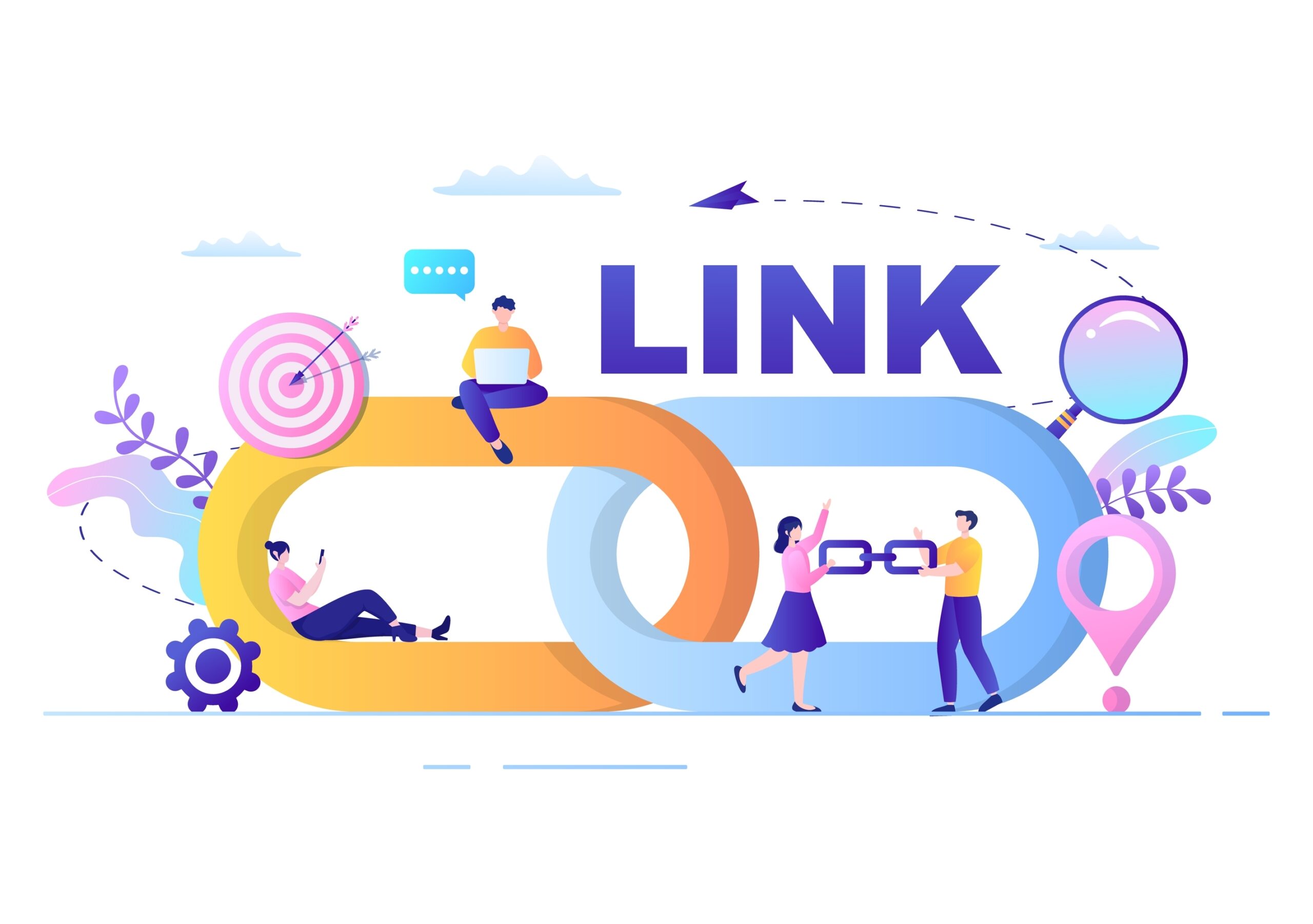Internal linking is an essential aspect of any business’s SEO efforts.
Besides making it easier for users to explore related resources and increasing time spent browsing your website, internal linking also helps Google understand the relevancy of your web pages.
In addition, it can positively influence your website’s rankings on search engines.
However, internal linking isn’t about inserting random links throughout your website and hoping that Google understands the connections between content pieces.
You should consider your overall website structure and follow best practices to ensure internal links are relevant and useful.
In this article, you’ll discover how to build a robust internal linking strategy so website visitors and search engines can find your content.
What Are Internal Links (Compared to External Backlinks), and Why Are They Important?
Structuring your web pages with internal links is essential to ensure your website ranks on Google.
Creating a structure for your website that includes all of your web pages ensures that Google will always be able to find them.
Here’s an example of why this type of structure is important.
Currently, our website has profile pages that appear on the sitemap but aren’t linked to from other pages.
To best set ourselves up for success with internal linking, our next step is to create a higher-level page that gives these pages a core place to live.
This will also help Google understand that these pages are related to each other and create context around the meaning of the pages.

Ideally, you want to structure your website in a way that helps Google bots crawl your site more efficiently.
A strong link-building strategy consists of two primary efforts: internal linking and external backlinking.
Internal links are links on your website that link to other pages within your website.
On the other hand, external links are links on other websites that link to pages within your website. There are a number of helpful tools available for tracking external links if you’re looking to increase these efforts.
As an aspect of technical SEO, internal links support necessary website structure, show the relevancy of connected web pages, and help Google find all of your pages for inclusion in search results.
In the same way, a user follows links and finds related pages on your website, Google follows links on your website to find new content.
To help Google spiders crawl your website more efficiently, you’ll want to ensure you have a structure for your website pages.
If you have orphan pages—pages that aren’t linked to from any other pages on your website—you’ll make it more difficult for users and search engines to find what they need.
As seen in this example from Moz, you’ll want to avoid orphan pages by maintaining a solid internal linking structure.
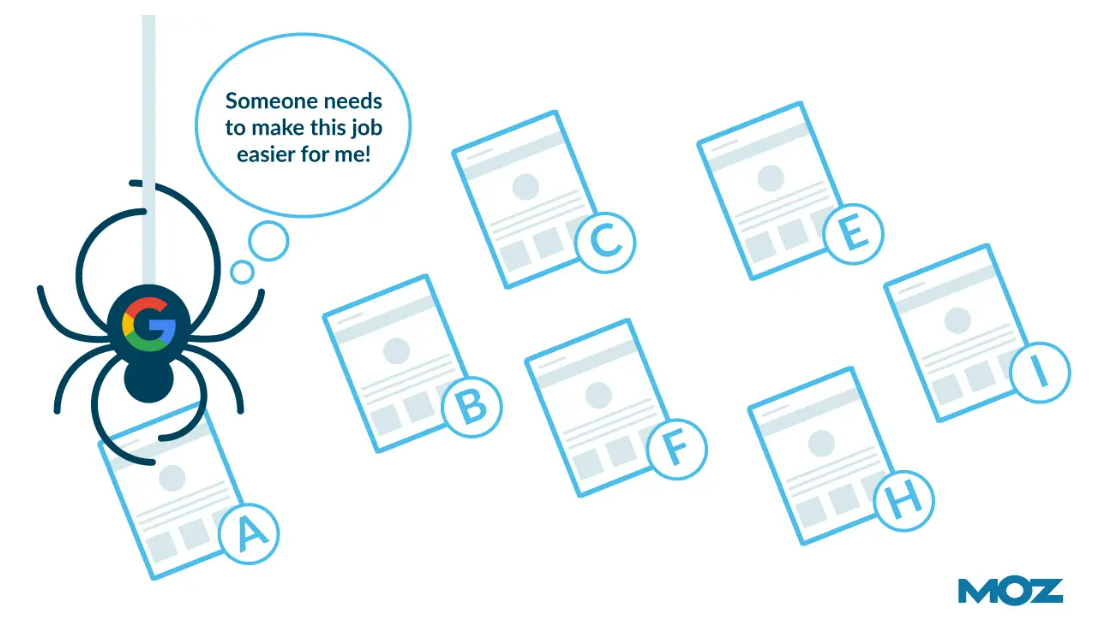
In this case, one of Google’s spiders has found a single page on a website—perhaps the homepage. Without internal linking, it will be more challenging to find the other pages and rank them in search results.
Even if you have well-researched content and valuable resources, it won’t matter if no one can easily find your web pages.
What Strategies Can You Use for Internal Linking?
There are a number of internal linking strategies you can use to help visitors find your website, including creating pillar pages and building page authority.
For instance, our SEO pillar page includes in-depth information and links to our SEO-focused blogs and resources.
Without a higher-level page, our SEO content would float on our site with no clear connection between each piece.
Pillar pages, also known as cornerstone content pieces, contain related posts and resources in one spot and provide detailed information on a specific topic.
They also help organize content and show connections between related web pages.
The image below shows our structured approach to our SEO pillar page. The content from this page dictates what we write about (shown in blue).
It also helps create a content calendar so we know what topics we should cover next (shown in yellow).
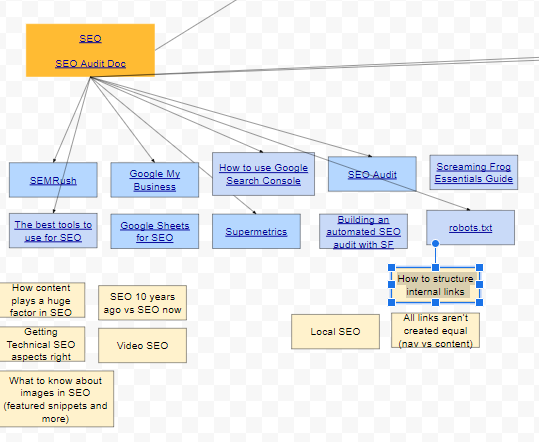
Page authority is another consideration to keep in mind.
It’s likely that certain pages on your site are stronger and have more authority in Google’s eyes. This mostly stems from how much traffic and links these pages receive.
For the most part, these stronger pages should be pillar pages.
A key aspect of this strategy is linking older pages with lots of authority on your site to newer pages on your site.
You’ll want to link to each relevant post and have each post link back to the pillar page.
With this linking strategy, you can show Google the connection between different pages and make it easier to understand the context.
Ideal Website Architecture
Now that we’ve discussed what internal links are and how you can use them let’s look at how to structure your website to best support internal linking.
Overall, the optimal architecture for your website is a pyramid-like structure.
Your homepage should link to relevant pages, then each of those pages should link to more relevant pages, and so on.
Screaming Frog has a Visualise Site Architecture feature that conceptualizes your website’s structure for you.
The resulting image can be overwhelming if you have a large website, though.
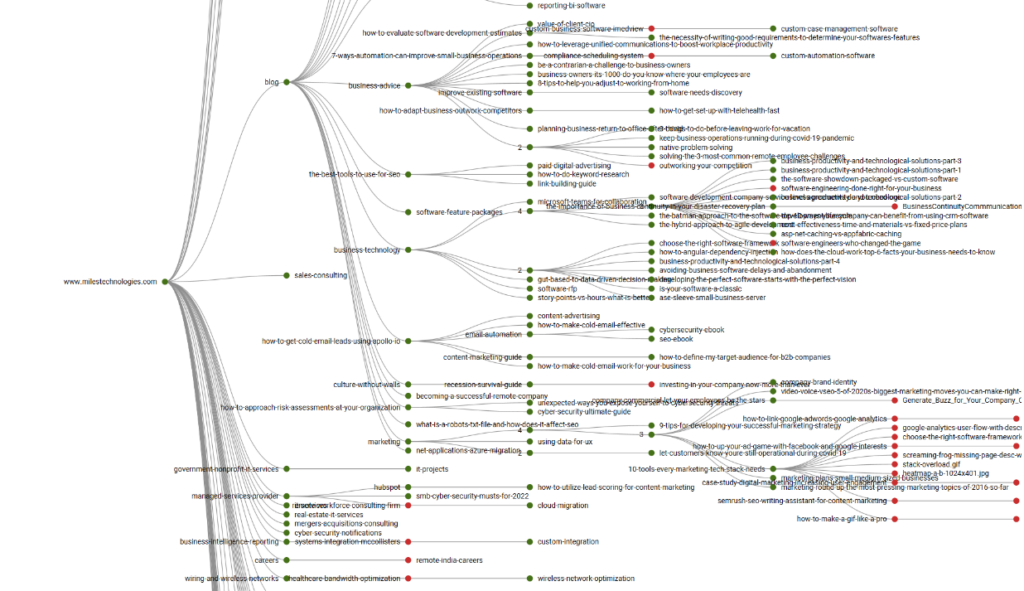
Your ideal website architecture should look more similar to this example from Moz.
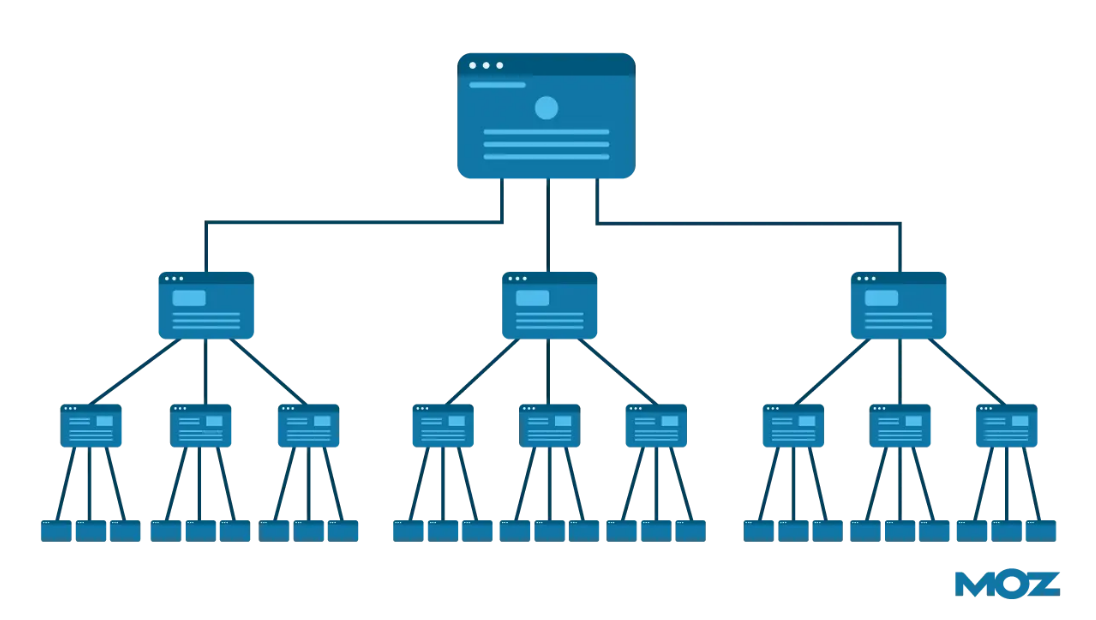
Although Screaming Frog doesn’t create a cleaner version of your site architecture like in the Moz example, you can still find necessary information based on your URL structure or meta keywords.
In general, pillar pages dictate which content you should link to, but remember that there can be overlap.
Some content pieces may fall under two or more pillar page categories.
You can always branch out from the pyramid structure as you add new topics and refine your strategy.
How does Google crawl my website?
Internal linking from the home page of your site is extremely important to your site’s searchability as a whole.
Typically, Google finds your home page first and follows the links included there.
Bots will initially look at your navigational links, moving from top to bottom, before crawling the internal links in the body of the content.
For example, our home page links to our top-level service and consulting pages.

From there, our top-level pages link to each of our individual service and consulting pages, making it easy for Google spiders to find them.
Keep in mind that it’s harder to find pages that aren’t linked.
Although search engines will most likely find them, they may skip some content.
You’ll want to make it as easy as possible for Google to find your web pages and know which pages you consider more important than others.
However, there are some pages of your site that you may want to restrict Google’s spiders from crawling, like thank you pages, test pages, or backend pages.
You can use the Robots.txt file to tell search engines not to crawl these pages as well by adding a “noindex” meta tag to these pages.
How Can I Optimize Internal Links?
Always remember that SEO and internal links work hand-in-hand to keep your website ranking and relevant.
One tip for internal linking is to link to pages in the body of your content as opposed to relying on navigational links. This is because pages in the navigation and footer of your site are visible on every page so it’s considered “easier” to link to other pages.
This also allows you to give more context to your internal links with anchor text.
Linking to pages in the body of your content is more valuable because it shows you care about what you are linking. It tells the reader that you’ve taken the time to ensure the link is relevant and will further their understanding of the topic.
Naming Conventions
When creating and optimizing internal links, it’s important to follow best practices for naming them.
Anchor text is the text on your page where the link is displayed.
Using descriptive words and key phrases in your anchor text can establish context for users and search engines.
Varying anchor text for the same resource can help Google better understand the content’s topic.
For instance, you don’t want every link to your SEO pillar page to read “SEO pillar page.”
This image from our automated SEO audit shows the anchor text we use when linking back to our SEO pillar page, including words like “technical SEO,” “SEO strategy,” and “SEO improvements.”
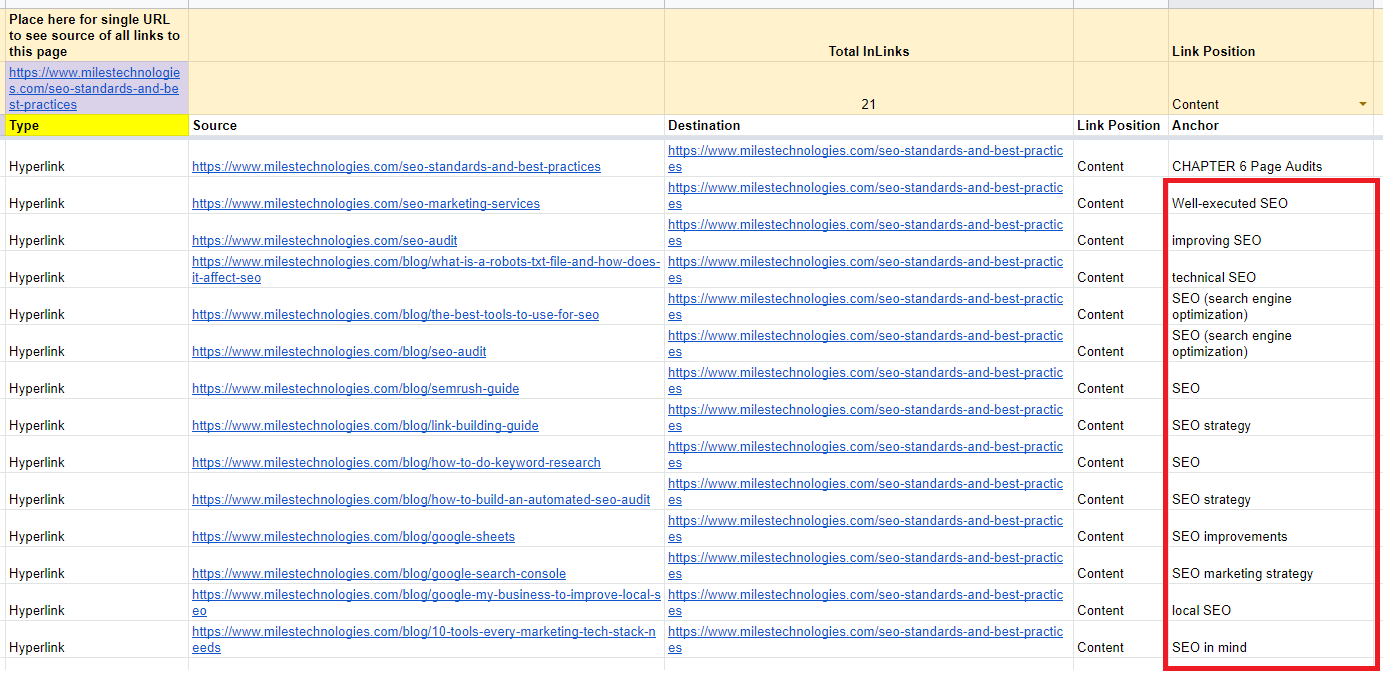
Varying anchor text gives Google more clues about the page’s content using latent semantic indexing LSI, which means using synonyms so search engines can understand the full context.
How to Keep Up with Your Internal Link Structure
Now that you know the basics of internal linking, you may be wondering how to keep your strategy up-to-date and consistent.
It’s important to remember that internal linking isn’t a one-and-done process.
In the same way your website should change based on your business’s evolving services, you should continually add internal links to your pillar pages and other resources as you publish new content.
Yoast summarizes the value of a strong internal linking strategy, noting that it can help boost overall website fitness. Internal links also show the relevancy and importance of your web pages and the correlation between related topics.
Here’s a checklist of tips to keep your pillar pages and blogs up-to-date with the most recent and accurate internal links.
- Every time you update a new blog, make sure you’re linking back to every pillar page or relevant sub-topic
- After blogs are posted, once a month (preferably sooner if you can), review your pillar page and make sure it links to all relevant blogs
- Ensure any service pages on your site link to helpful resources
- For example, we recently published a blog on ways to approach risk assessment blog. We plan to link to this article from our new cybersecurity services page to provide more context on how we conduct penetration testing and other assessments
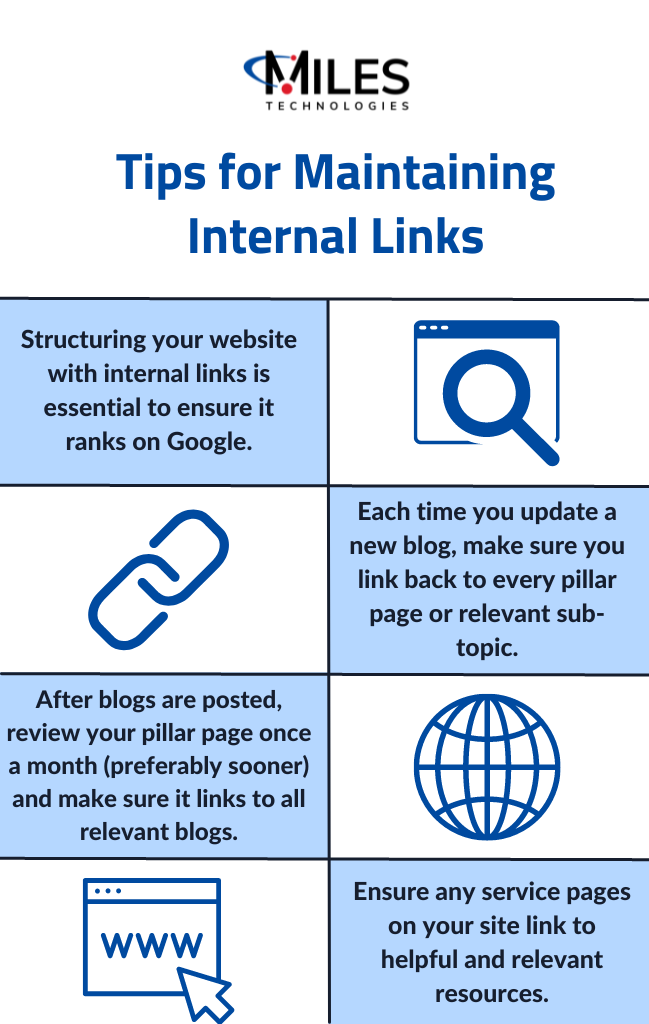
How Many Internal Links Are Too Many?
On a single page, you shouldn’t be linking to every page that ever existed on your site.
Typically, longer pages deserve more links. Including 100 internal links within three paragraphs of content is too much, but 100 internal links within a 5000+ word blog post aren’t out of the question, as long as they continue to be useful and relevant.
Follow these best practices to ensure you’re not overwhelming readers or Google.
- Make sure links are relevant. You likely won’t have too many if you only include links to related resources.
- Make sure links are useful. Linked content should go further in-depth on a specific topic, provide access to a valuable resource, or provide opportunities for the reader (or search engine) to explore more.
- Make sure you link only once per page to the same resource. For instance, we wouldn’t link to our SEO pillar page three times within our blog about the essentials of Screaming Frog.
- Keep internal links higher on the page. Linking to your most important page (like your pillar page) within the first three paragraphs of your content is ideal.
Make sure links are relevant. You likely won’t have too many if you only include links to related resources.
Make sure links are useful. Linked content should go further in-depth on a specific topic, provide access to a valuable resource, or provide opportunities for the reader (or search engine) to explore more.
Make sure you link only once per page to the same resource. For instance, we wouldn’t link to our SEO pillar page three times within our blog about the essentials of Screaming Frog.
Keep internal links higher on the page. Linking to your most important page (like your pillar page) within the first three paragraphs of your content is ideal.
How Do You Find Internal Linking Opportunities?
Finding the right places for internal links on your website is integral to keep your link strategy updated and cohesive.
For instance, our SEO Marketing Services page is valuable to link to from our industry pages and marketing pages, since SEO is relevant for every industry and a major aspect of digital marketing.
To understand the internal links directed to this page, we use a link report that pulls info automatically from Screaming Frog.

This report allows us to discover instances of pages that don’t have enough links to them.
In this case, we have 24 internal links to our SEO Marketing Services page. For additional clarity, we can see exactly which pages link there.
Another strategy for finding internal linking opportunities is maintaining an organized visual architecture of your website.
This can help you see at-a-glance which content pieces are related to a specific overarching topic.
In addition, this architecture can keep your content creation efforts on track.
Overall, places, where you can increase context and give users more clarity are excellent for internal links.
Conclusion
Internal linking is a valuable SEO strategy that can increase the visibility of your website content.
From a technical standpoint, it helps search engine bots crawl your website more efficiently and understand the purpose of your site and content.
From a user standpoint, it makes resources more accessible and encourages visitors to continue exploring your website—exactly what you want as a marketer.

